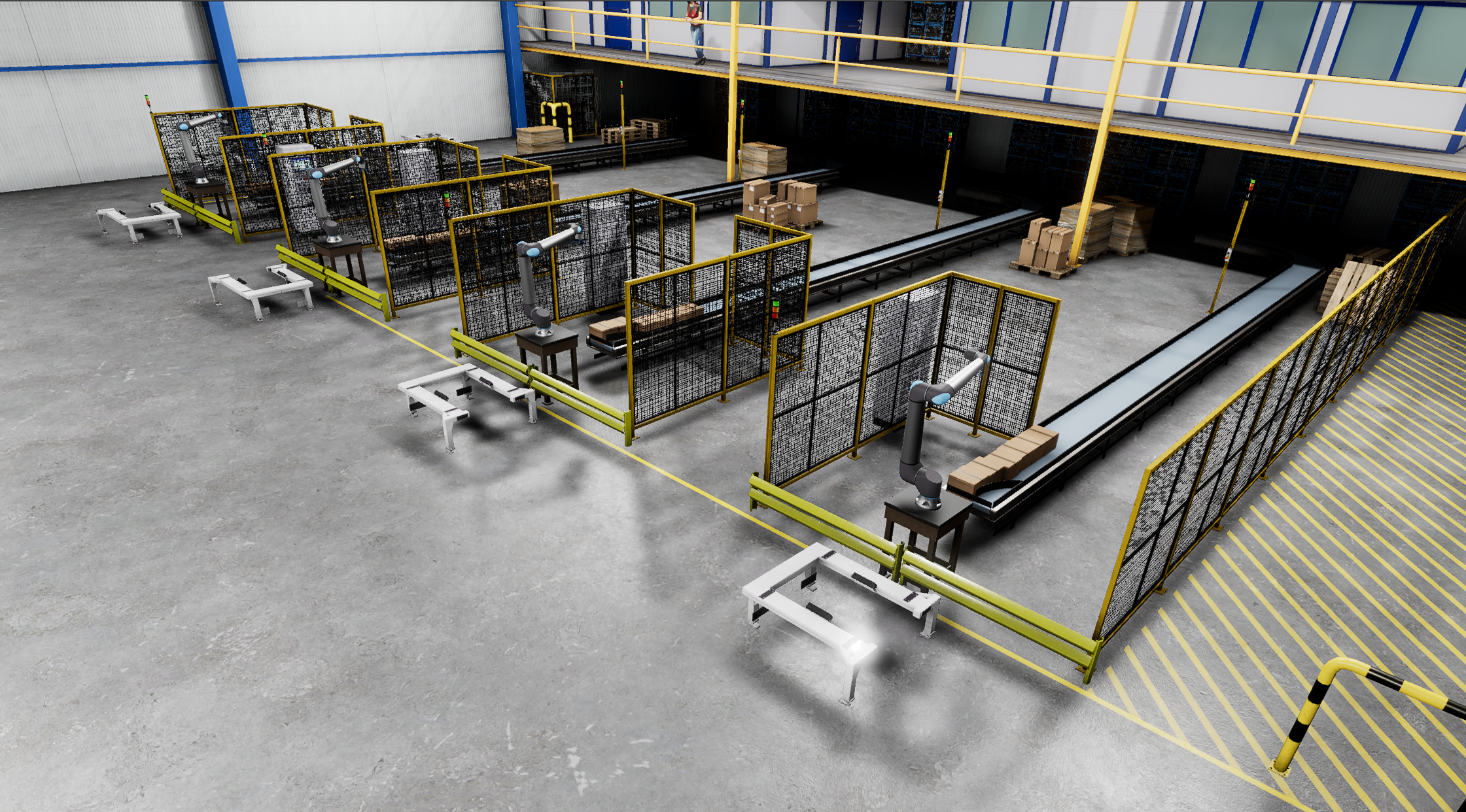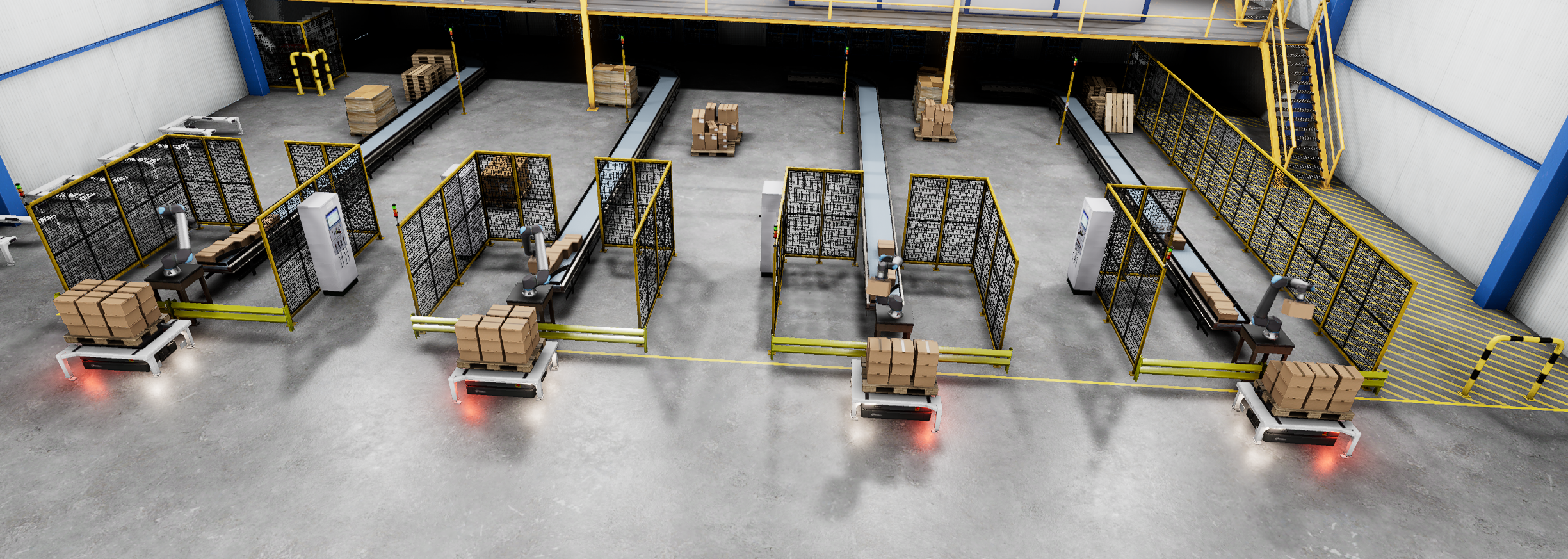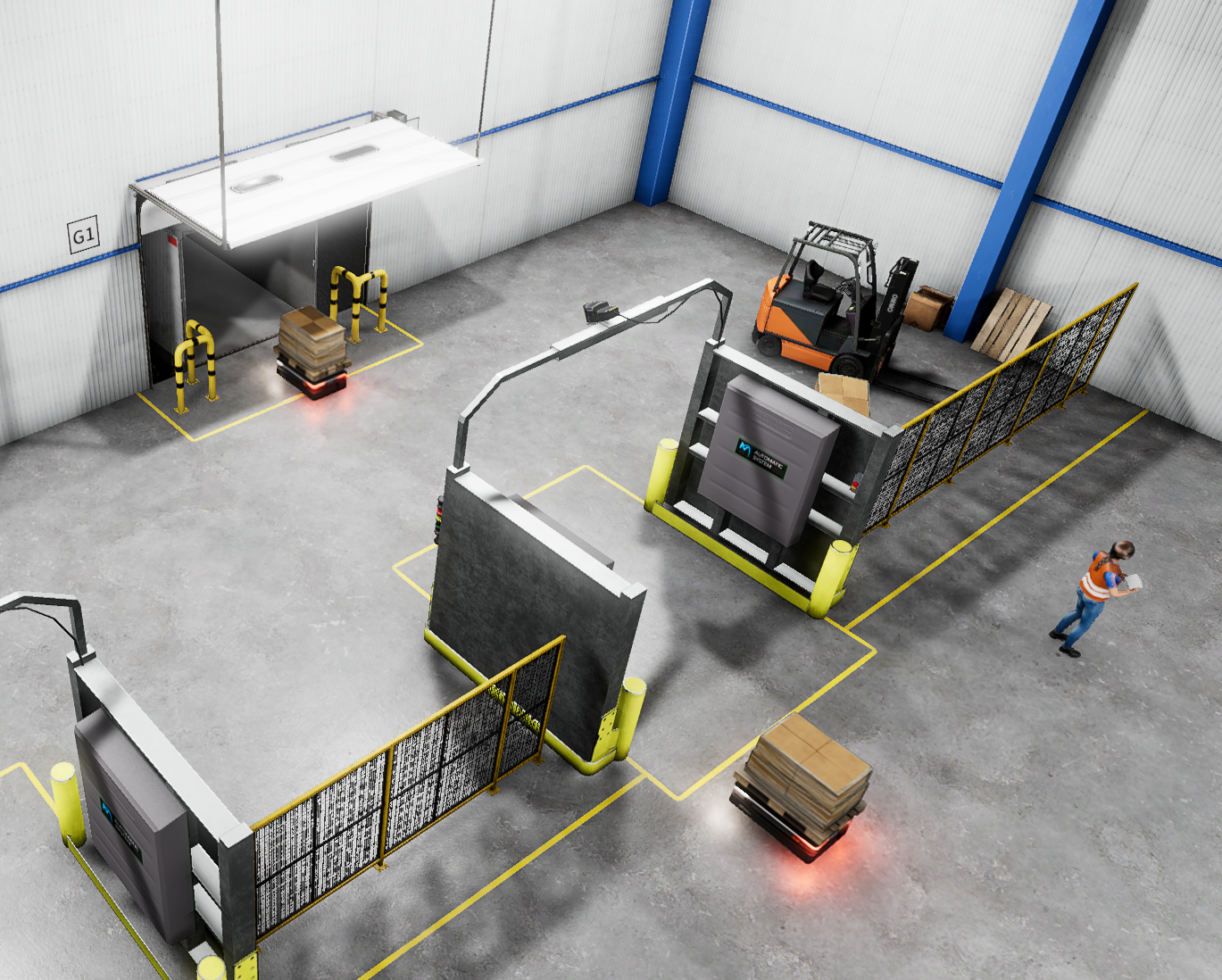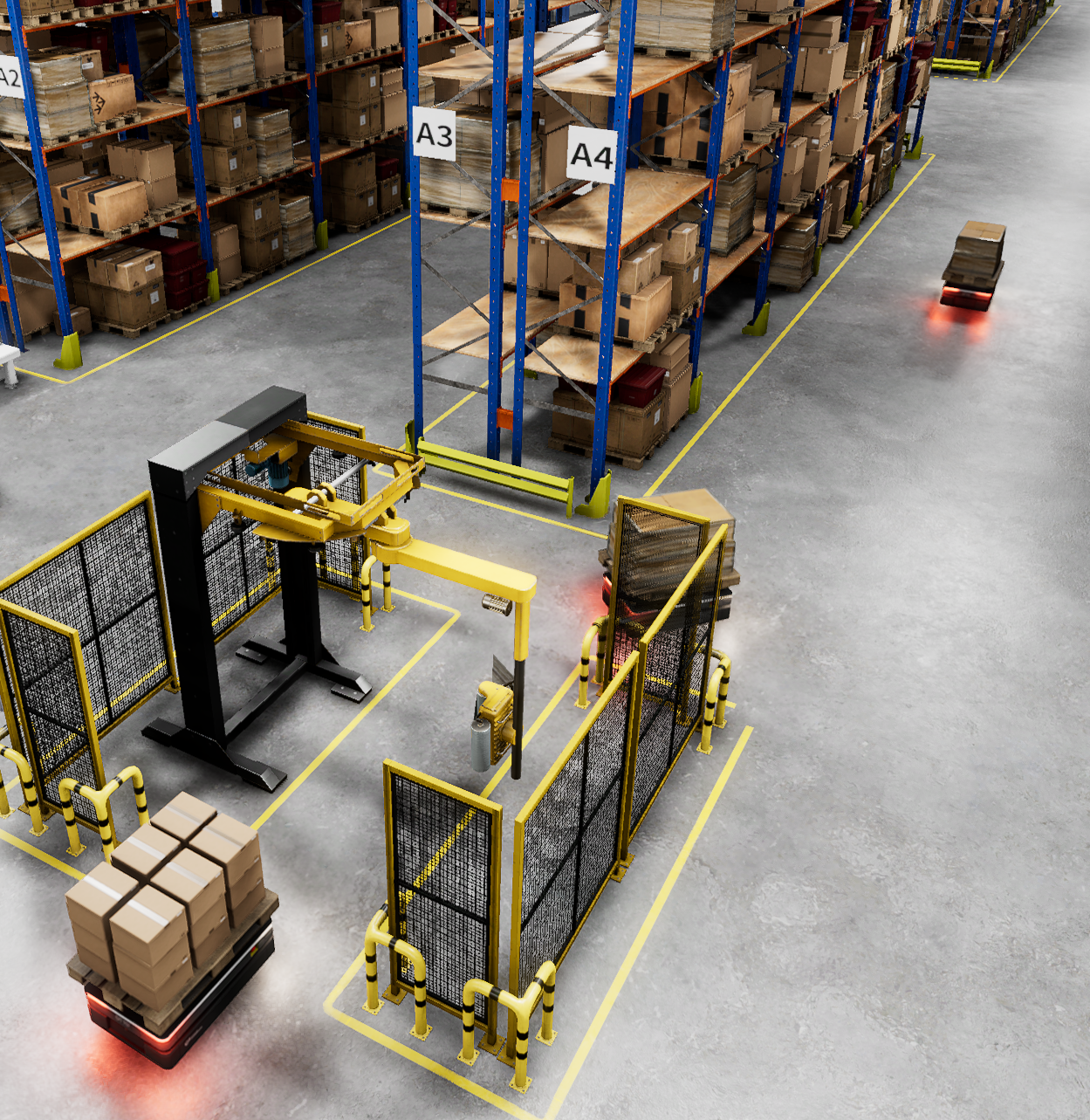Robotized fulfillment center
An Open 3D Engine (O3DE) multi-robot demo.
The project
This project demonstrates O3DE use for a complex robotic simulation through integration with modern ROS 2 stacks: nav2 and MoveIt2. You can learn more about the features of O3DE for robotics and how to get started in O3DE documentation.
Levels
- DemoLevel1: 30x100 meters scene with 4 conveyor belts, 4 robotic arms. Suitable for 4-8 AMRs.
- DemoLevel2: 90x100 meters, three times larger, 12 robotic arms, suitable for 12-24 AMRs.
- RobotsSuperShot: a level showcasing 3D models, with several different robots, a human, and a forklift. Some robots are not equipped with components yet, but you are welcome to try and make them work!
- RobotImportLevel: a small enclosed space with a table, good for importing your own robot.
Detailed description
UR20 robot arms controlled by MoveIt2 with pilz_industrial_motion_planner. Boxes are supplied by conveyor belts, which are implemented through spawning when below a certain number in an area. UR20 arms are placing boxes based on a ground truth vision system, which means they actually look at the scene and that there is no error in pose measurement. UR20 arms start working as soon as an immobile pallet is detected in their load area and will load a configurable number of boxes (up to 18, by default 18) on each pallet.
Pallets are moved around by robots modeled after OTTO 600. Note that these AMRs do not use the software of real OTTO 600 and do not have the same sensors. They can navigate thanks to front/back lidar and operate cargo lifts. OTTO 600 robots have assigned task loops, which are loading, wrapping, and delivering cargo to the other end of the warehouse. They use nav2 action server to realize their paths, and also a custom path follow solution for docking and unloading (for simplicity). Note that robots follow their task independently but see and avoid each other.
In the warehouse, you can also notice some humans walking around. Note that they don't see robots, as they use navigation through a Gem and only consider static scene objects.
How does it look like
The project includes
- Scenery that initially created using a Warehouse project template, but lot of new models have been added.
- Robotic Arms imported using URDF description provided by Universal Robotics for their UR20 collaborative robot .
- AMRs instantiated prefabs of OTTO600 and OTTO1500 robots from OTTO Motors.
- Boxes that are transported using conveyor belts from Warehouse Automation Gem and palletized.
Requirements
Platforms
The project runs on Ubuntu 22.04 with ROS 2 Humble or ROS 2 Iron.
💡 Note: This demo is not supported on Windows!
Hardware
The demo is rather demanding, as it aims to show what is possible. Minimum specs are not determined, but we ran it on:
- NVIDIA GeForce RTX 3070 GPU (8 GB).
- Intel i7-11800H (16 cores) CPU.
- 64 GB RAM.
For more FPS, larger scene, or more robots, consider:
- NVIDIA RTX 3080 Ti (or better) GPU (16 GB).
- Intel i7-12900KF (24 cores) CPU.
Project Setup
ROS 2 middleware
This project should be used with the rmw_cyclonedds_cpp as the ROS 2 middleware.
MoveIt2 does not recommend usage of the default RMW and as it is a part ot this project using the default RMW will not work.
Install the CycloneDDS RMW by installing its package:
sudo apt install ros-${ROS_DISTRO}-rmw-cyclonedds-cppAfter the installation add this command to your .bashrc or equivalent file.
export RMW_IMPLEMENTATION=rmw_cyclonedds_cppThis will change the default RMW implementation to CycloneDDS. Source your new configuration:
source ~/.bashrcNote: The ROS2 daemon may need to be restarted to use the CycloneDDS RMW. Use
ros2 daemon stopandros2 daemon startto restart the daemon.
O3DE
- Refer to the O3DE System Requirements documentation to make sure that the system/hardware requirements are met.
- Please follow the instructions to set up O3DE from GitHub.
- Use the
mainbranch (version 2310.0).
The following commands should prepare O3DE:
cd {$WORKDIR}
git clone --branch main --single-branch https://github.com/o3de/o3de.git
cd o3de
git lfs install
git lfs pull
python/get_python.sh
scripts/o3de.sh register --this-engineROS 2 Gem and other gems
This project uses the ROS 2 Gem, Warehouse assets Gem and Warehouse automation Gem. Please make sure to follow the installation guide in the Project Configuration file up until the creation of a new Project.
To learn more about how the Gem works check out the Concepts and Structures.
Note that the Gem instructions include the installation of ROS 2 with some additional packages.
Use the roscon2023demo branch, which is a bit ahead of stable 2310.
During build use AZ_USE_PHYSX5:=ON to enable PhysX 5.1. It is essential for articulation.
We assume that the directory with the project is ${WORKDIR}.
Clone o3de-extras repo
cd ${WORKDIR}
git clone https://github.com/o3de/o3de-extras
cd o3de-extras
git lfs install
git lfs pullAnd register required Gems:
cd ${WORKDIR}
./o3de/scripts/o3de.sh register --gem-path o3de-extras/Gems/WarehouseAssets
./o3de/scripts/o3de.sh register --gem-path o3de-extras/Gems/WarehouseAutomationThe Gems are open to your contributions!
RGL Gem (Optional)
Optionally, especially when intending to run more robots or change their lidar to a higher resolution one, you can enable and use Robotec GPU Lidar Gem (RGL Gem). Please follow instructions in the RGL Gem repository, register it (see above) and enable within the project. Following that, change the OTTO 600 prefab so that both front and back lidars use the GPU lidar (use combo box to select it).
ROS 2 packages
Make sure to install the necessary ROS 2 packages.
sudo apt install ros-${ROS_DISTRO}-ackermann-msgs ros-${ROS_DISTRO}-control-toolbox ros-${ROS_DISTRO}-nav-msgs ros-${ROS_DISTRO}-gazebo-msgs ros-${ROS_DISTRO}-vision-msgs ros-${ROS_DISTRO}-nav2-msgs ros-${ROS_DISTRO}-ur-msgs ros-${ROS_DISTRO}-moveit-servo ros-${ROS_DISTRO}-moveit-visual-tools ros-${ROS_DISTRO}-moveit ros-${ROS_DISTRO}-pilz-industrial-motion-planner ros-${ROS_DISTRO}-controller-manager ros-${ROS_DISTRO}-ur-client-library ros-${ROS_DISTRO}-nav2-commonProject
You need to build and source the ROS 2 workspace first as it contains custom messages that the simulator also uses.
This workspace depends on submodules that need to be pulled first. This is done through the script (setup_submodules.bash) that selects a submodule's version based on the detected ROS 2 distribution.
cd ${WORKDIR}/ROSCon2023Demo/ros2_ws
./setup_submodules.bashNow install all dependencies of submodules.
sudo apt install python3-colcon-common-extensions python3-vcstool
rosdep update
rosdep install --ignore-src --from-paths src/Universal_Robots_ROS2_Driver -yNow build and source the workspace.
cd ${WORKDIR}/ROSCon2023Demo/ros2_ws
colcon build --symlink-install
source install/setup.bashThe source command needs to be done in the same console where you build and run O3DE.
Assuming that project's repo was cloned to {$WORKDIR}:
cd {$WORKDIR}/ROSCon2023Demo/Project
cmake -B build/linux -G "Ninja Multi-Config" -DLY_DISABLE_TEST_MODULES=ON -DCMAKE_EXPORT_COMPILE_COMMANDS=ON -DLY_STRIP_DEBUG_SYMBOLS=ON -DAZ_USE_PHYSX5:=ON
cmake --build build/linux --config profile --target Editor ROSCon2023Demo.AssetsTo launch the built project:
cd {$WORKDIR}/ROSCon2023Demo
./build/linux/bin/profile/EditorRunning the simulation
Open the level: DemoLevel1.prefab.
Launch the O3DE simulation by clicking CTRL + G or by clicking the launch arrow next to the Play Controls in the top right corner.
Now go to the ros2_ws folder and run the all ros2 packages.
cd {$WORKDIR}/ROSCon2023Demo/ros2_ws
source install/setup.bash
ros2 launch roscon2023_demo ROSCon2023Demo.launch.pyIn a few seconds, the robots should spawn and start moving. For a more in-depth explanation see the ros2_ws/README.md.
NOTE: By default, 4 robots are spawned. To change the number of robots see #changing-robots-amount paragraph.
Troubleshooting
If you intend to switch between Humble and Iron distributions, it is best to perform a clean build, or at least rebuild ROS 2 and RGL Gem. Make sure you build the workspace and the simulation project with the same distribution (rebuild and source on change).
If your simulation does not work as intended, please first make sure you sourced the workspace properly before running the project.
Please also refer to the common Troubleshooting Guide.
Notes and acknowledgments
This demo project was originally developed by Robotec.ai in cooperation with AWS Game Tech and AWS RoboMaker.



